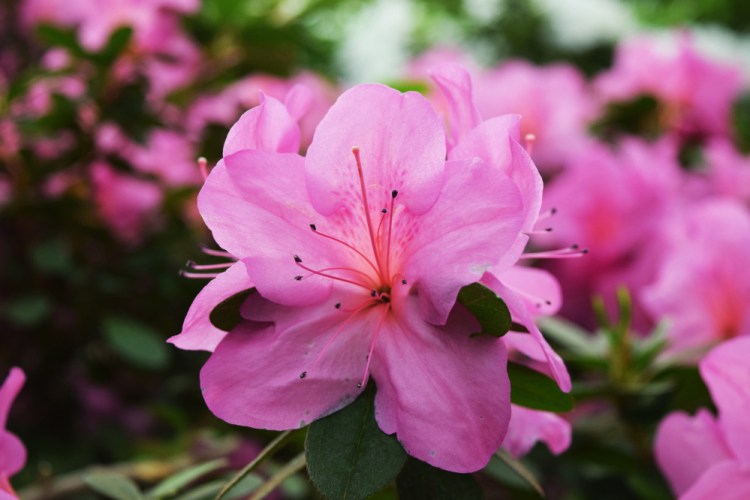A shade garden is the most natural kind of planting for Maine. We are a forested state, and forest trees are the largest part of shade gardens.
While most plants prefer full sun, and gardeners with full sun have a wider selection, there are still plenty of beautiful plants that do well in shade.
Let’s start with some definitions: A full-sun garden gets at least six hours of sun in the middle part of the day, from about 9:30 a.m. to 6:30 p.m. That is when the sun is strongest. Light shade is four hours a day, and can be dappled sun. Partial shade is a glade in a forest, with a bit of sun and reflected light. Full shade is under a thick canopy of trees or on the north side of a building.
If you’re starting with a new property and want a shade garden, add native deciduous trees, such as oaks, poplars, birches, red or sugar maples and willows, to create the shade you want. They will provide food for the native insects, birds and animals that are part of the Maine ecosystem.
Most people interested in creating a shade garden already have those trees and looking to deal with the shade they create.
The soil under these canopy trees is usually acidic, with plenty of organic material from leaves that have fallen to the ground and composted. Most shade plants thrive in those conditions.
Plants that do well in shade deal with the lack of sunlight in different ways.
The first flowers you see in a shade garden are the spring ephemerals, which often bloom before the leaves come out on the canopy trees.
Bloodroots are among the earliest flowers in our garden. They take full shade and can stand dry conditions. We have some with double flowers, which are showier, and some with single flowers. When the flower is in bloom, its leaves are wrapped around the stem. Once the bloom is past, the leaf comes out and then goes dormant in mid-summer.
Other native ephemerals include trout lily, Canadian mayflower and trillium. Of the three, the trillium – which can be maroon or white – has the showiest flower. While we have some in our garden, I see them most often when at my favorite fishing spots near Bethel. The ephemerals can be difficult to grow from seed, so it is best to buy seedlings from a local nursery.
Understory trees and shrubs are the showiest part of a shade garden.
Viburnums are some of the best, producing white flowers (some of them fragrant), with many also producing berries that last throughout the winter. All of them take partial shade, but the witherod viburnum (also called wild raisin) that I wrote about two weeks ago takes the most shade.
Hemlocks are an outstanding evergreen for shady conditions, and while the species hemlock grows 70 feet tall, there are dwarfs that range from 5 to 25 feet tall. We have one that does very well under our neighbor’s Norway maples, a tree that is on the state’s banned invasive-plant list and that provides the densest shade. With shorter varieties of hemlock, you can spray against the woolly adelgid, which has hit some areas of southern Maine.
Hollies thrive in the shade, both the native winterberry and the more common types used for Christmas decorations. We prune ours every December to bring inside for decorations.
The shrubs people think of first for shady conditions are rhododendrons and azaleas. Most are not native, but they have large, bright blossoms and require little care. They have an extended bloom time, from May until July, depending on the variety. They do very well in acid soil, and the rhododendrons and many azaleas keep their leaves all year long.
Pieris, or andromeda, is not native but it is beautiful and the variety Brouwer’s Beauty is especially striking.
Once the spring ephemerals have gone by, you need a group of other perennials growing close to the ground.
One of the best natives is lobelia, or cardinal flower. It is a native and one of the first plants to establish in a forest disturbed by fire or blow-downs. It grows about 3 feet tall with bright blossoms, and it likes wet conditions.
Aruncus, or goatsbeard, is a native with large white blossoms that likes moist soil. It blooms in midsummer and looks a bit like an oversized astilbe.
Nancy and I have Solomon’s seal in several areas of our garden. It is a low-maintenance native – some people complain that it’s a bit too aggressive – that grows 4 feet tall and has creamy bell-shaped flowers hanging from its arched stems. There is also a variegated version that grows 2 feet tall. Both take full shade.
Cimicifuga, or black snakeroot, is another tall native that makes a statement in the garden. Some of them grow up to 8 feet tall with bottle brush-shaped flowers.
And we haven’t even gotten to hostas yet. They aren’t native, but these are the plants most people think of for shady areas, grown mostly for their foliage even though they have blossoms in late summer. The leaves can be blue, green or variegated with yellow or white in many different patterns. They are a favorite food for deer, however. If you have problems with deer, plant blue hostas. The color is caused by a waxy substance, which deer don’t like.
You also will want some grasses. One of our favorites is Hakone grass, which has mounds of arching green and gold leaves that move in the wind. Its texture provides a good contrast when mixed in with hostas and astilbes.
Shade gardens are a peaceful place, especially during the hot days of summer. Enjoy yours during the months ahead.
Tom Atwell is a freelance writer living and gardening in Cape Elizabeth. He can be contacted at 767-2297 or at: tomatwell@me.com
Send questions/comments to the editors.



Comments are no longer available on this story